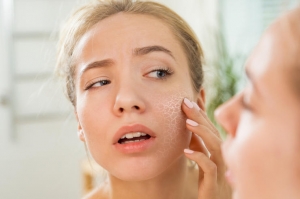Even at a young age, the skin does not always have a uniform tone, as lifestyle and stress to which the skin is exposed predisposes to the appearance of blemishes. After menopause, unfortunately, this phenomenon spares few people. What causes skin spots, and what can you do to avoid them? This will be discussed in this article.
Age spots are part of the aging process and can be more or less obvious and numerous. This depends on genetics, as well as on the lifestyle that the woman led before menopause. For example, if a woman smoked, had a poor diet, exposed herself to harsh ultraviolet rays, or led a stressful lifestyle with always high cortisol levels, then she may suffer more from age spots.
What happens to the skin barrier after menopause? The epidermis becomes thinner, cell turnover slows down, and this leads to a number of consequences. Clusters of keratin form, the skin becomes harder on the surface, but thinner. The production of natural moisturizing factor decreases, so it becomes increasingly difficult to moisturize the skin. Sebum secretion decreases, causing the skin to become drier. This creates an imbalance in favor of oxidative stress.
Why does oxidative stress occur? After menopause, not only the main external antioxidant, sebum, is lost, but also antioxidants inside the skin. Therefore, the body does not have enough vitamin E and therefore tocopherol and squalene on the surface to counteract the oxidative stress caused by the sun's rays. Anabolic functions are reduced. Anabolic functions are those that provide collagen synthesis and antioxidant activity. This leads to an imbalance between oxidants and internal endogenous antioxidants. Oxidative stress itself can cause menopausal spots to appear.
Another element associated with oxidative stress is lipofuscin, which is a collection of pigmented granular molecules. Lipofuscin is present in cells throughout our lives, with the difference that this substance is usually phagocytosed , that is, it is digested and utilized as it is synthesized. This prevents the accumulation of pigmented molecules. With age, due to the same oxidative stress, the level of free radicals is too high, and the internal antioxidant system that controls these accumulations cannot cope with its work.
What to do and what not to do? It is important to take preventive measures so that spots appear as late as possible. It is advisable to minimize all factors that may contribute to their appearance: smoking, poor diet, ultraviolet rays, stress and exposure to a polluted environment. Lifestyle adjustments will benefit a woman both before and after menopause.
The biggest mistake you can make during menopause is trying to speed up cell turnover with chemical peels , exfoliation and other aggressive methods in the hope of making the epidermis brighter or more uniform. In fact, the opposite effect will occur.
The natural separation of the stratum corneum keeps the skin elastic , compact, moisturized and resistant to external influences. The compact stratum corneum is located immediately below and represents our skin barrier, which, together with the more superficial stratum corneum, controls hydration. This barrier consists of corneocytes ( CER ) of a certain structure, and if they are stimulated by constant peeling , the physiological turnover time is reduced, and the skin barrier will consist of so-called fragile corneocytes ( CEF ). These corneocytes form an incomplete barrier, and therefore, the skin will not only not be able to retain water on the surface, capturing it from the environment, but will not even be able to control the physiological transpiration of the skin from the underlying layers. Thus, a woman receives not only a damaged skin barrier, but also constantly dehydrated skin. And this leads to loss of elasticity, protection from UV rays and the external environment.



















